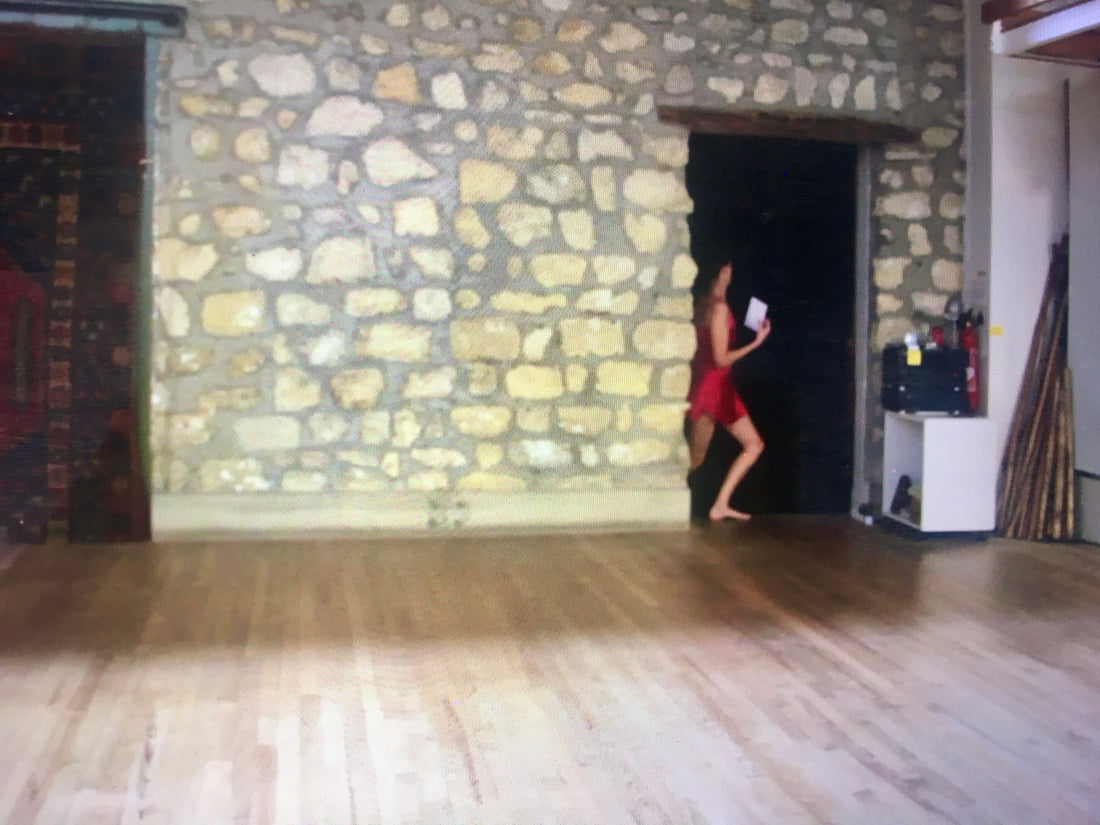
Review of The Science of Night, Studio Chandon, Paris, Sunday 4th September 2022
The Science of Night
Studio Chandon, 280 rue Lecourbe, 75015 Paris
Sunday 4th September 2022
Reviewed by Ziata Annun
The diaries of Anais Nin, the poetry of Pablo Neruda and the life story of Marie Duplessis – a woman known to most of us as the inspiration for La Dame aux Camelias – evoke an atmosphere of erotic longing, loneliness and finally, death: a release from the anguish of romantic love. Connecting these themes with an interpretation in dance, added a dimension to the literature which was entirely unforeseen and deeply affecting.
Juliet Shelley’s work has, over the years, developed a highly personal narrative expressed through a combination of movement, soundscapes and objects meaningful to her. For this piece, her first performance in Paris, her connection to Marie Duplessis began with a soundscape of combined voices as she entered the performance space. Seated, she wrote a letter, the last appeal to her lover; giving one the sense of anguish and hope, hope that she might have a life-saving response.
For this first of four parts to the piece, she wore grey – symbolic of illness. Juliet Shelley’s movements were slow as she portrayed the weight of sorrow, drawing empathy and anticipation from all corners of the auditorium. The grey of the 19th century predicament for a woman entering the last stages of her illness – a century in which science had not yet found cures.
For the second part, Juliet entered the stage in full length black chiffon accentuating her tall and slender body – exceptionally so for a dancer – which together with the elegant strength of her finely honed movement imbued the whole piece with a sense of excitement. The seemingly effortless precision of her movements, which her entire body from the tips of her fingers to the tips of her toes as one audience member put it, could only have been achieved by tireless, disciplined rehearsal.
No movement appeared vague. Each movement connected to the next in a way that produced abstract, flowing shapes, seamlessly and most importantly, surprisingly. Even shockingly at times. Tones, shades, nuances of meaning were translated into movement as Juliet Shelley used her long-limbed slenderness to great effect.
The third part – dressed in fresh green chiffon silk – introduced an intensely joyful, optimistic character to the piece; as if a new dawn or Spring season was in the air. The soundscape was a combination of voices: Italian, spoken with gentle musicality by Jannina Veit Teuten overlaid with English spoken in a darker timbre, by Juliet and tinged with a sorrowful note. Together, harmony in the sound made by two different languages spoken simultaneously, it was an inspiring touch, open to interpretations of Nature and optimism tinged with caution.
Each frame of a film of this piece would stand alone as a work of Strength in Beauty.
The final part was Marie Duplessis, in camelia pink silk, fluttering in her hands the letter she had written with such endearing sincerity in the first part of her piece. Could it be that the letter was never sent? Where did her courage go?
The poignancy of this piece with its combination of coquette and victim, dressed in a seductive camisole brought this woman’s predicament to the fore. This time accompanied by the 19th century letter spoken out loud, overlaid by a contemporary piece composed by Keone River Shelley.
What has changed and what has remained the same? A question posed at the beginning of the piece. How do we live with our own natures, within Nature? How do we trust ourselves to receive love and to give love in these times? The juxtaposition of the past century of Marie Duplessis, Anais Nin and Pablo Neruda with the 21 st century of technological interface was presented here: are they in opposition?
The world of Science will explore and research for centuries to come, disappearing into its own Black Hole. But Night?
No, night is night just as love is love.
With references to the context of Anais Nin, Pablo Neruda and Maria Duplessis in the introduction to the piece, an accompanying example of their writing would have been a thought-provoking kind of programme to take away. On the other hand, they were starting points; where they led to was left to the audience. On this particular occasion, the audience, apparently made up of a number of dancers, took to the stage to improvise a response. One by one, then in twos and threes, using the soundtrack of The Science of Night. It was mesmerising. The ‘response piece’ was sustained and recognisable, suggesting to this reviewer that the themes and questions of The Science of Night were ones that chime within us all.
Ziata Annun, independent art reviewer, UK & Europe.
ziataannun063@gmail.com
La Science de la Nuit
Studio Chandon, 280 rue Lecourbe, 75015 Paris
dimanche 4 septembre 2022
Révisé par Ziata Annun
Les journaux intimes d'Anais Nin, la poésie de Pablo Neruda et l'histoire de la vie de Marie Duplessis - une femme connue de la plupart d'entre nous comme l'inspiratrice de La Dame aux Camelias - évoquent une atmosphère de désir érotique, de solitude et enfin de mort : une libération de l'angoisse de l'amour romantique. Relier ces thèmes à une interprétation en danse, a ajouté une dimension à la littérature qui était totalement imprévue et profondément émouvante.
Le travail de Juliet Shelley a, au fil des ans, développé un récit très personnel exprimé à travers une combinaison de mouvements, de paysages sonores et d'objets significatifs pour elle. Pour cette pièce, sa première représentation à Paris, sa connexion à Marie Duplessis a commencé par un paysage sonore de voix combinées alors qu'elle pénétrait dans l'espace de représentation. Assise, elle écrivit une lettre, le dernier appel à son amant ; donnant un sentiment d'angoisse et d'espoir, l'espoir qu'elle pourrait avoir une réponse salvatrice.
Pour cette première des quatre parties de la pièce, elle portait du gris - symbole de la maladie. Les mouvements de Juliet Shelley étaient lents alors qu'elle décrivait le poids du chagrin, attirant l'empathie et l'anticipation de tous les coins de l'auditorium. Le gris de la situation difficile du XIXe siècle pour une femme entrant dans les dernières étapes de sa maladie – un siècle au cours duquel la science n'avait pas encore trouvé de remèdes.
Pour la deuxième partie, Juliette est entrée en scène en mousseline noire sur toute la longueur, accentuant son corps grand et élancé - exceptionnellement pour une danseuse - qui, avec la force élégante de son mouvement finement aiguisé, a imprégné toute la pièce d'un sentiment d'excitation. La précision apparemment sans effort de ses mouvements, que tout son corps, du bout des doigts au bout des orteils, comme l'a dit un membre du public, n'aurait pu être obtenue que par une répétition inlassable et disciplinée. Aucun mouvement n'apparaissait vague. Chaque mouvement se connectait au suivant d'une manière qui produisait des formes abstraites et fluides, de manière transparente et surtout, de manière surprenante. Même choquant parfois. Les tons, les nuances, les nuances de sens ont été traduits en mouvement lorsque Juliet Shelley a utilisé sa sveltesse aux longs membres avec un grand effet.
La troisième partie – habillée de mousseline de soie verte fraîche – a introduit un caractère intensément joyeux et optimiste à la pièce ; comme si une nouvelle aube ou une saison printanière était dans l'air. Le paysage sonore était une combinaison de voix: l'italien, parlé avec une douce musicalité par Jannina Veit Teuten, superposé à l'anglais parlé dans un timbre plus sombre, par Juliet et teinté d'une note douloureuse. Ensemble, harmonie dans le son fait par deux langues différentes parlées simultanément, c'était une touche inspirante, ouverte aux interprétations de la Nature et à l'optimisme teinté de prudence.
Chaque image d'un film de cette pièce serait à elle seule une œuvre de Strength in Beauty.
La dernière partie était Marie Duplessis, en soie rose camélia, voletant dans ses mains la lettre qu'elle avait écrite avec une si attachante sincérité dans la première partie de sa pièce. Se pourrait-il que la lettre n'ait jamais été envoyée ? Où est passé son courage ? Le caractère poignant de cette pièce alliant coquette et victime, vêtue d'un caraco séduisant, a mis en évidence la situation difficile de cette femme. Cette fois accompagnée de la lettre du 19ème siècle prononcée à haute voix, recouverte d'une pièce contemporaine composée par Keone River Shelley.
Qu'est-ce qui a changé et qu'est-ce qui est resté le même ? Une question posée au début de la pièce. Comment vivons-nous avec nos propres natures, au sein de la Nature ? Comment nous faisons-nous confiance pour recevoir de l'amour et donner de l'amour en ces temps ? La juxtaposition du siècle passé de Marie Duplessis, Anaïs Nin et Pablo Neruda avec le 21 e siècle de l'interface technologique a été présentée ici : sont-ils en opposition ?
Le monde de la science explorera et recherchera pendant des siècles, disparaissant dans son propre trou noir. Mais la nuit ? Non, la nuit est la nuit tout comme l'amour est l’amour.
Avec des références au contexte d'Anais Nin, Pablo Neruda et Maria Duplessis dans l'introduction de la pièce, un exemple d'accompagnement de leur écriture aurait été une sorte de programme stimulant à emporter. D'autre part, ils étaient des points de départ ; où ils menaient était laissé au public. A cette occasion particulière, le public, apparemment composé de plusieurs danseurs, est monté sur scène pour improviser une réponse. Un par un, puis par deux et par trois, en utilisant la bande originale de La science de la nuit. C'était fascinant. Le « morceau de réponse » était soutenu et reconnaissable, suggérant à ce critique que les thèmes et les questions de La science de la nuit étaient ceux qui résonnaient en nous tous.
Ziata Annun, critique d'art indépendante, Royaume-Uni et Europe.
ziataannun063@gmail.com

1 comentario
Yes, I too was in the audience for this performance. Sublime. I hope more people will have the chance to see it.